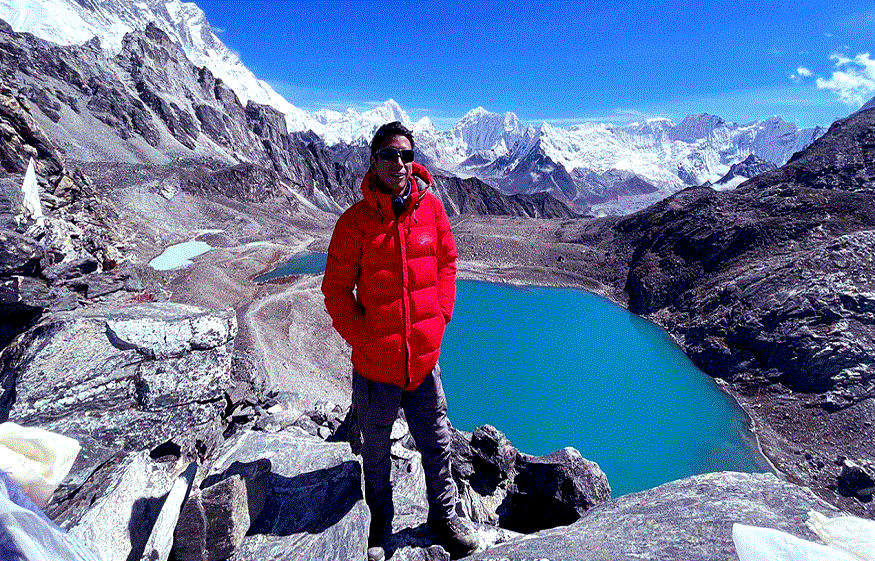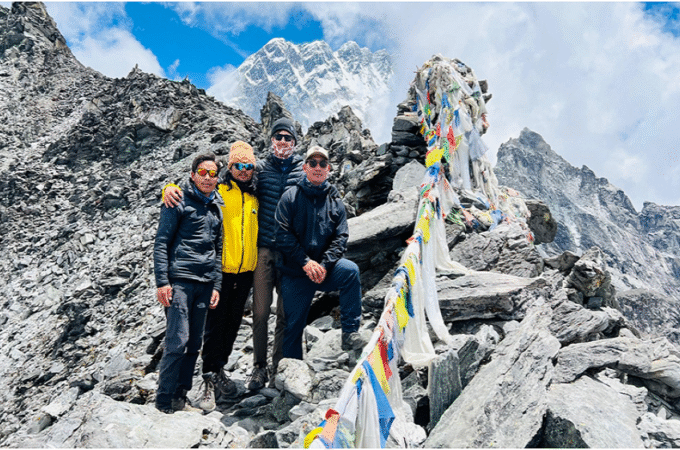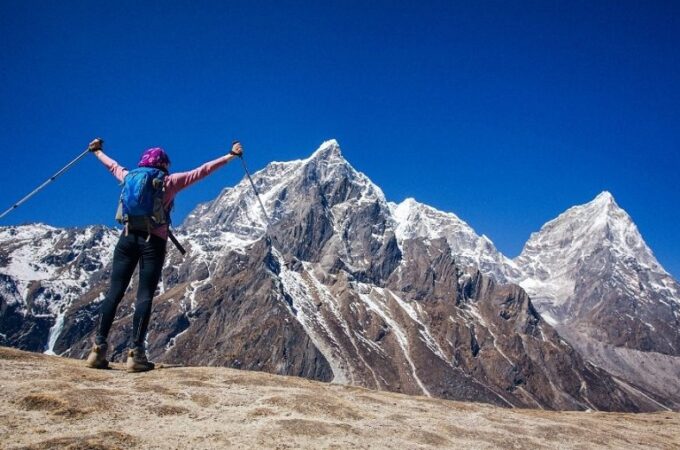
How Sherpas Make the Everest Three High Passes Trek Possible and Unforgettable
The Everest Three High Passes Trek is an exciting adventure through the rugged landscape of the Khumbu region, with spectacular views of some of the highest Himalayan peaks. Nonetheless, the difficult hike wouldn’t happen or be nearly as memorable without the help of the Sherpa, who are a fundamental part of making this trip as safe and memorable as possible. Native Sherpas have an unparalleled understanding of the topography and a strong relationship with the mountains. Their knowledge, experience, and hospitality are what make the hike an effortless experience for travelers.
Everest Three Pass Trek Extreme weather, challenging ascend routes and altitude sickness are just some of the trials presented in the high-altitude environment of the Everest region. Sherpas possess remarkable physical capability and are well accustomed to high-altitude environments, which makes them indispensable to trekkers. They lead trekkers over the daunting routes, helping to make the journey manageable and secure. Their experience with the terrain enables them to traverse the treacherous trails, where others may grapple to find their bearings.
Sherpas carry heavy loads as well, so it greatly reduces the burden off the trekkers to let them focus on the beauty of the trek as well as the challenges instead of the physical strain. They cook, set up camp, and help with the logistics so that the trip goes off without a hitch and is enjoyable. They are the ones cheering you on and lifting you up when things get difficult — they shout words of wisdom and motivation.
Sherpas provide not only practical and logistical support but also a deep-seated cultural and spiritual connection to the land. As guardians of the Everest region, they tell stories of the mountains as well as their culture and their deep respect for nature. This cultural refinement makes the trek not only a physical challenge but also a transcendental experience full of wonder and reverence.
The Sherpas are the spirit and electricity behind the Everest Three High Passes Trek, and as such, they make the trek possible and improbable at the same time.
Everest Three High Passes Trek Overview
Everest Three High Passes Trek is one of the most challenging and rewarding treks in the Himalayas. Located in Nepal, this trek leads adventurers through some of the world’s most rugged and beautiful terrain. The path involves crossing three high-altitude passes, Kongma La, Cho La, and Renjo La, each of which is over 5,000 meters. This trek is mostly done through high passes like Mount Everest (8848 m), Lhotse (8518 m), Makalu (8481 m) and Cho Oyu (8188 m), offering an incredible experience for trekkers.
The trek starts in Lukla, a small town that can be reached by a flight from Kathmandu, and it takes trekkers through traditional Sherpa villages, lush forests, and high-altitude terrain. Trekking also visits iconic locations like Namche Bazaar, Everest Base Camp and Gokyo Lakes along the way. More than just a physical challenge, this trek also offers cultural exploration, providing trekkers with an opportunity to immerse themselves in rich Sherpa heritage. Because of its elevation and challenging terrain , it demands a degree of fitness and acclimatization, which means it is best suited to reasonably fit trekkers.
Everest Three Pass Trek Cost Though the Everest Three High Passes Trek brings beautiful sights and an exhilarating sense of accomplishment, it can develop into a demanding physical challenge due to altitude gain and rugged terrain. That is why it is crucial to have a seasoned guide and a support team to navigate the arduous journey safely and successfully.
Sherpas: An integral part of Himalayan expeditions
Sherpas have always been associated with Himalayan expeditions, especially in the Everest region. Sherpas, an ethnic group native to the southeastern region of Nepal, were known worldwide for their outstanding mountaineering skills, strength, and resilience in the extreme altitudes of the Himalayas. The Sherpa people’s long-standing relationship with the mountains, with their ability to endure extreme conditions, has made them invaluable to trekking and climbing expeditions throughout the region.
Sherpas guide, carry loads and provide logistics on many trekking routes including the Everest Three High Passes Trek. Since most people are not familiar with the rigorous expectations of the Himalayas, their expertise in the terrain, the environment, the climate, and the acclimatization process greatly benefits trekkers. Sherpas can sometimes carry the heavy loads, set up the camps and assist in making sure the trek goes well. They help with navigation, as well, alerting trekkers to potential hazards on the trail, and offering insights into the local culture and history.
Besides their physical prowess, Sherpas have a unique understanding of high-altitude physiology. They are the ones who make sure climbers do not ascend too fast and thus split the risk of mountain sickness. Without their help, many of the world’s monumental mountaineering achievements, including summit bids on Everest, may never have occurred.
Who are Sherpas and what is their History and Cultural Significance?
Everest Three Pass Trek Package The history of the Sherpa people, who hail from the Tibet region, is closely linked to the mountains of Nepal. The word “Sherpa” alone translates to “eastern people” in Tibetan and they are thought of as a people group due to their development over centuries of time in the tough, remote territory of the Solu-Khumbu district, close to Mount Everest. Sherpas, who are native to the Himalayas, are known for their unique climbing skills, which they refined by virtue of living in high-altitude regions.
Historically, Sherpas also served as traders, moving goods between Nepal and Tibet, sometimes through treacherous mountain passes. However, their place in the world’s mountaineering history became clear in the mid-20th century, starting with the expeditions to Mount Everest. The legendary Tenzing Norgay, summited Everest in 1953 with Sir Edmund Hillary, famously solidifying the Sherpa’s place in global mountaineering history.
Culturally, Sherpas practice an amalgamation of Tibetan Buddhism and animism, and their religious rituals have direct connections to the mountain topography where they live. Castles, prayer flags, and chortens (Buddhist shrines) line the trekking routes of the Everest region, and to Sherpas, the mountains are sacred. This fundamental reverence and respect for both nature and spirit is woven into the fabric of Sherpa culture, giving trekkers a distinct insight into Himalayan culture as they traverse these remote areas.
How to prepare for the Everest Three High Passes Trek
As a high-altitude trek, with technical climbs and altitude sickness risk, taking part in the Everest Three High Passes Trek requires plenty of preparation. Trekkers should prepare themselves perfectly before taking any journey to avoid any hiccups during their journey.
You should give yourself a few months of preparation as far as fitness for cardiovascular endurance, strength, and stamina building. Preparedness: Researching the types of trails your trek will encounter is a good way to prepare yourself so that you’ll already know how to navigate those terrains better, and activities like hiking, running, or stair climbing are old-fashioned ways of ensuring both your legs and your lung endurance is at its best. Trekkers should also do exercises that strengthen their core and legs, as these will be key when tackling steep slopes and rugged lands.
It is crucial to pack the right gear. Other essentials are warm clothes, a decent sleeping bag, trekking poles, and well-fitted shoes suitable for high-altitude hikes. It’s equally critical to pack sufficient layers to deal with the wide temperature peaks and valleys in the mountains. Aside from going in the best shape they can, trekkers should educate themselves about the dangers of altitude sickness and prepare for proper acclimatization by going up to higher altitudes in stages.
Everest Base Camp Three Pass Trek Finally, find a good trekking agency that offers you qualified guides, and supporting staff like Sherpas as they help you have a successful and safe visitation. The Everest Three High Passes Trek is a stunning and challenging trek, and with the proper planning and attitude, trekkers can enjoy this trek as well as the beauty and challenge it provides.
The Sherpas — Essential Accompaniment on the Trek
Trekkers Who Undertake Everest Three High Passes Trek, Sherpas Watts In Practical Role Guide With Practically The Knowledge Of Adventuring Bulls You’re In Derescueral Scene And Deteriority Of Whole Town While being a guide – and thus, guiding clients through treacherous routes, remote villages, and high-altitude passes – is one of the most important jobs of a Sherpa, Their detailed understanding of the landscape, including dangers like avalanche zones or unstable routes, significantly minimizes danger for trekkers.
Sherpas are climbing guides who carry a large part of the load, hauling trekking gear and supplies to certain camps. This lets trekkers concentrate on their journey and save tiredness of body for the actual trek. Moreover, Sherpas are experts at high-altitude adaptation, counseling trekkers on rest days, hydration, and how best to avoid altitude sickness.
Culturally, Sherpas serve as a window into the locals’ way of life, helping suitably to serve as cultural ambassadors as trekkers learn about Sherpa traditions, Buddhism, and mountain spirituality. They are also an emotional and social support, often getting close to trekkers and offering confidence through treks’ tough days. The Everest Three High Passes Trek would be impossible and so much less fun without Sherpas and that just goes to show that they are absolutely essential to any Himalayan adventure!
The Difficult Terrain: Sherpa Expertise
The Everest Three High Passes Trek offers some of the most challenging terrain you’ll encounter while trekking with steep ascents, icy tracks, rocky scrambles, and narrow ridges. But traversing this treacherous terrain takes more than just physical strength — it takes a familiarity with the land, of which Sherpas have years of experience. Having navigated through treacherous terrain before, high altitude porters are just the right, and individuals as trekkers are considered.
Sherpas have trained for generations based on experience and oral tradition. They know how to plot safe trails along steep and rocky slopes, icy surfaces, and areas susceptible to rockfalls or avalanches. Their deep knowledge of the mountains helps them guide trekkers safely, particularly in unpredictable, or low-visibility, weather.
Three Pass Trek Moreover, sherpas in the trekking exhibition not only guide the trekkers but maintain the safety of the trekkers, helping trekkers identify the track and ensuring they are safe around the difficult passes, including Kongma La, Cho La, Renjo La, etc. They help to make crucial decisions about timing, rest breaks, and safety measures. Their guidance is vital not just for executing the trek successfully but for pulling it off safely and with respect for the unforgiving terrain. At that point, here comes the necessity of a Sherpa, his knowledge of the challenging landscapes of the Everest Three High Passes Trek is something unconditional to any successful trek.
Sherpas and High Altitude and Acclimatization Knowledge
Sherpas are known for their incredible ability to acclimatize to high altitudes, which is important for trekkers traveling through the Everest region. Residing at elevations over 10,000 feet in the Himalayas, the Sherpas have had their bodies adapt to succeeding in low-oxygen circumstances, so they’re priceless relating to expertise on altitude illness and the precautions to take. They have extensive knowledge of altitude and acclimatization protocols, and they know just how to guide trekkers over the potentially deadly phases of the Everest Three High Passes Trek.
Sherpas are expert guides to how altitude impacts the human body and can advise trekkers on pacing, ensuring a gradual ascent and proper times for rest. The new altitude perspective, hydration, nutrition, and recommendations on the right clothing to help prevent altitude-related maladies like AMS (acute mountain sickness) is of utmost importance. Sherpas also have an innate sense of when a trekker may be in danger of altitude sickness and stop experiencing symptoms well before the trekker themselves. Not only does this maximize safety but it enriches the overall experience whilst the trekker can appreciate the beauty of the landscape without worrying about the risk of altitude-related illnesses.
Decades spent scaling up to the world’s highest peaks and knowledge of altitude and acclimatization passed down through generations have made the Sherpas indispensable to those who seek to reach those lofty summits. Their wisdom, developed through both experience and a love for the mountains, ensures they are invaluable companions on high-altitude treks.
Why Sherpas Are Important for Not Only Safety But Finding Help in Case of Emergencies
From the Everest Three High Passes Trek to the rest of the world, Sherpas are the people who make sure trekkers are safe. This trek is difficult and even dangerous due to the rugged landscape, extreme weather, and altitude sickness. They have trained in managing diverse emergencies — from first aid to precarious situations involving bad weather and challenging terrain.
When the unexpected occurs — altitude sickness, injuries — Sherpas are often the first responders. They’re trained in basic medical care and are able to provide immediate assistance, stabilizing trekkers before seeking additional medical treatment. They know the terrain so well that they can quickly judge risks and act accordingly. Sherpas are familiar with the safest routes to descend in case emergency evacuation is needed and can quickly make arrangements with rescue teams.
Everest Three Pass Trek Itinerary In addition to keeping trekkers physically safe, Sherpas look out for their mental health as well. Having them around provides comfort knowing that they are seasoned professionals and have seen it all in the Himalayas. Be it a sudden storm or a medical emergency, the Sherpas’ cool, calm, collected behavior and decisive actions play a vital role in tracking and managing these situations, ensuring the journey is as secure as possible.
From the best trekking experience to the safety of the trekkers, these guides do it all, but in times of high-stress conditions, their ability to act swiftly and efficiently is what makes them irreplaceable when it comes to Everest expeditions.
Endurance and physical capabilities of sherpas
Sherpas are legendary for their physical endurance, developed from years spent living in the Himalayan mountains, which is a high-altitude environment. This resilience is crucial not only for their survival but also for their capacity to assist trekkers during challenging expeditions, such as the Everest Three High Passes Trek. Sherpas carry heavy loads, often much larger than what trekkers themselves might carry, making arduous, long climbs with packs that count between 50 kilograms (110 pounds).
Sherpas are used to the altitude, the punishing terrain, and the harsh weather, which gives them the physical strength and endurance to carry out such herculean tasks. Their bodies have trained in a low-oxygen environment, and they glide through the site of a thousand other failed expectations. This resilience makes them an extreme help to trekkers for managing the difficult physical tasks of a trekking expedition like carrying equipment, preparing food, or establishing camps.
It’s not just the strength; their physical abilities extend to speed and agility under challenging conditions. Also known for their exceptional skill of climbing steep slopes and negotiating rocky trails, Sherpas reach isolated places often many hours ahead of trekkers. It is one of the primary reasons why they are the backbone of the expeditions in the Everest region; they are incredible physical specimens.
Faced with the most difficult conditions, the endurance of the Sherpas is critical to guarantee the success of the trek and the safety of the people accompanying them.
How Sherpas Impact the Trekker Experience
Sherpas play a crucial role in making the Everest Three High Passes Trek a memorable experience for the trekkers. While they have the technical know-how and physical strength needed to do the job, Sherpas offers a cultural richness for the trek that elevates it from purely a physical challenge. Trekkers cannot experience the Himalayas as they do without their warm hospitality, personal stories, and deep-rooted connection to the land.
From the first steps of a trek, the Sherpa fosters a sense of camaraderie and support. Their direction is practical and emotional, providing motivation and comfort as trekkers stretch their boundaries. Along the way, Sherpas frequently recount tales of their life, their culture, and the mountains themselves, providing trekkers with insight and respect for the history of the region. This cultural exchange is among the most deep-rooted experiences you will take away from trekking in the Himalayas — a challenging adventure often leads to a journey of the soul and spirit for countless.
Everest Three Pass Trek Map The Sherpas are also critical to logistics, arranging food, lodgings, and gear throughout the trek. Their level of detail means trekkers can focus on the experience itself, be that soaking in the views or feeling that sense of accomplishment after a high pass. Sherpas create the conditions in which trekkers feel safe, supported, and enriched by the experience.
They elevate the trek to something not merely achievable, but something memorable, leaving trekkers with a fondness and appreciation for Sherpas and their role in the adventure.
Economic and Social Contributions of the Sherpas to the Region
The book explains Brokpa culture, Sherpa customs, and the role they play in the economy and social development of the Everest region. Their presence is an essential avenue of income for the local communities beyond trekking logistics. The Khumbu region’s most important source of income comes from the tourism sector, led by trekking, with Sherpas at its core.
Sherpas directly contribute to the local economy through their work as guides, porters, and support staff. Their income supports not only their families but the broader community, with money earned from the trekking industry flowing into local businesses like lodges, restaurants and stores. Moreover, many Sherpas are investing their earnings into education, healthcare, and infrastructure that help better the region as a whole.
Socially, Sherpas play an important role in the preservation and sharing of the region’s cultural heritage. They are the bearers of the traditions, the language, the customs of their ancestors. In doing so, people receive value from the trekkers themselves and the trekkers leave unified. Their ability to talk and connect with trekkers promotes cultural exchange, enhancing not only the trekkers’ experience as guests of the world but also the lives of the Sherpas who host them.
Sherpas, through their work, and cultural contribution, are not only crucial for the economy but also, for the social texture of the region, managing to safeguard the unique way of living of the Everest community while defining its future.
Conclusion: Paying Tribute to the Sherpas of Trekking History
The Sherpas are the unsung heroes of trekking history, and without their help, the Everest Three High Passes Trek would not be possible. From their deep understanding of high-altitude environments to their steadfast dedication to the safety and well-being of trekkers, Sherpas have helped make some of the world’s most demanding treks possible. They propel the physical feats of trekking to a whole new level with their resilient endurance, impressive physical capabilities, and longstanding culturally relevant knowledge of the terrain — and they make the entire experience far richer, providing context and sense in a track around the foothills of the Himalayas.
Everest Three Pass Trek Price Sherpas support their families, lay the foundations of local communities, and are the beds of cultural heritage that ensure the region continues to thrive economically and socially. The money they spend in the trekking industry supports the local economy and builds genuine cross-cultural links between people from around the world and the communities they visit.
So, as the Himalayas remain the epicenter for trekkers from all walks of life across the world, it’s imperative to pay due respect that they deserve as an undefeated key piece of the world.” Together, they embody the living adventure that lies in the uncharted, and their defiance and tenacity serve as a model of strength and grace under the harshest circumstances. The Everest Three High Passes Trek and countless other Himalayan expeditions would not simply exist without Sherpas. It is their experience, knowledge, and spirit that transforms these treks into the experience of a lifetime.


